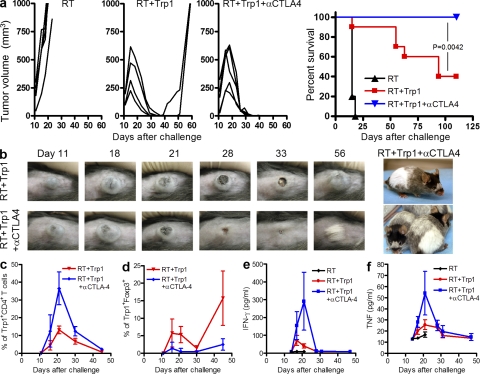Figure 1.
Transfer of small numbers of CD4+Trp1+ T cells in combination with radiation and CTLA-4 blockade produces potent rejection of established B16/BL6 melanoma tumors. Tumor-bearing mice were treated at day 10 with 5 Gy of RT and were injected or not with 50,000 naive tumor-reactive CD4+Trp1+ cells and anti–CTLA-4. (a) Data are presented as tumor growth in each mouse (three left panels; representative of at least three independent experiments; n = 5 mice per group) and cumulative survival from two independent experiments (far right panel; n = 10 mice per group). (b) Representative images of tumors in mice treated with 5 Gy of RT and CD4+Trp1+ cells in the absence (top) or presence (bottom) of anti–CTLA-4. The far right panel shows disseminated depigmentation in mice surviving therapy. (c–f) Blood samples from mice treated with 5 Gy of RT (black line), 5 Gy + CD4+Trp1+ (red line), and 5 Gy + CD4+Trp1+ + anti–CTLA-4 (blue line) were monitored at different time points after tumor challenge. Data are representative of three independent experiments (n = 5 mice per group). c shows the percentage of CD4+Trp1+ T cells from blood lymphocytes, whereas d depicts the percentage of Foxp3+ cells within the CD4+Trp1+ population. Serum samples were analyzed over time and tested for levels of IFN-γ (e) and TNF (f). Error bars represent means ± SD.

